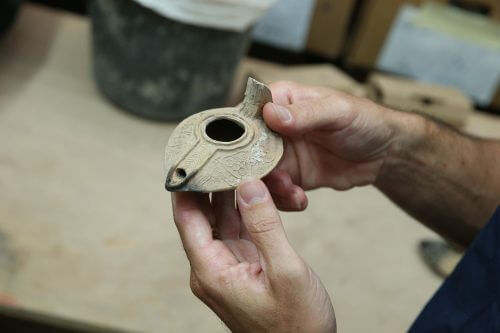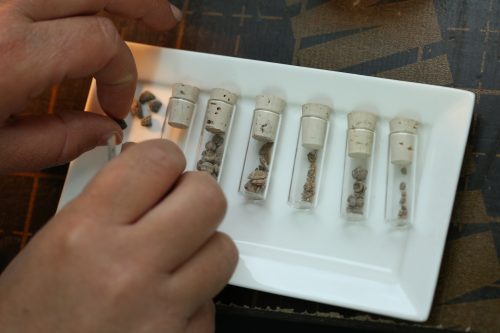An approximately 1,100-year-old garbage pit discovered in the excavations of the Antiquities Authority in the National Park surrounding the walls of Jerusalem testifies to the dietary habits of the early Muslim period

When did the eggplant arrive in Israel? The investigation of an ancient 1,100-year-old garbage pit, which was uncovered in archaeological excavations in the City of David in the National Park surrounding the walls of Old Jerusalem, may provide an answer to this question. In the pit, from the early Muslim period (the reign of the Abbasid dynasty, 940-750 CE), eggplant seeds were identified - the earliest known in Israel, in addition, thousands of vine seeds, olive seeds, jujube, mulberry, lentils, figs and more were discovered. The contents of the pit were excavated and studied in an archaeological dig managed by the Antiquities Authority in the City of David, funded and initiated by the Al Ir David (Al-D) association.
According to Nahshon Zanton, the director of the excavation on behalf of the Antiquities Authority, "Workshops and markets, by the nature of their activity, produced a lot of waste that was sometimes buried in garbage pits dug nearby. The archaeological findings from the garbage pits provide tangible evidence to write in the historical sources of the period, and provide valuable information about the dietary habits, lifestyle and economic relationships of the local residents of Jerusalem and the neighboring countries from about 1,100 years ago. The eggplant seeds, which arrived here from the Peres region, are just one example of the research potential inherent in ancient garbage."
In the garbage pit that was uncovered in the excavations of the terraced street in the city of David, various tools were found, including a candle bearing the inscription "Barakah" (blessing) in Arabic, cattle bones, fish and birds, and many seeds. These represent a variety of foods and plant products - legumes, fruits, vegetables, and also edible wild herbs, which were used, in addition to food, as spice and medicinal plants.
The contents of the pit are in the midst of research conducted by Oriya Amichai and Nachshon Zanton on behalf of the Antiquities Authority, in collaboration with the Archaeological Botany Laboratory at Bar-Ilan University, led by Prof. Udi Weiss.

According to Antiquities Authority researchers Oriya Amichai and Nachshon Zanton, "The finding of thousands of grape vines in the garbage pit may indicate the existence of an industrial activity that dealt with the fruit of the grape, and it is possible that they made wine instead, or more likely - dibs (grape honey). It is known that with the Islamization of the country, the importance of the divas industry in the region increased, and at the same time, the production of wine was reduced against the background of the Muslim religion's ban on drinking alcohol."
To the surprise of the researchers, among the many botanical varieties found in the pit, an eggplant was also identified. Identifying eggplant seeds for the first time in Jerusalem, and as far as we know for the first time in the entire country, provides important information about the beginning of its rooting in local agriculture. According to them, "During this period, the inhabitants of the country were exposed to new varieties of fruits and vegetables that arrived here following the Persian occupation. Some of them, like the eggplant, even became a common agricultural-local crop. These agricultural developments led to a change in the diet of the local residents, and thus, due to the arrival of new species and tastes in the region, it became more diverse than it had been up until then. It seems that this was one of the periods in which the character of the well-known Eastern Mediterranean cuisine, based significantly on vegetable and fruit crops, took shape."
The researchers note that "the botanical find was revealed thanks to a rare and unique mineral phenomenon that occurred in the garbage pit in the excavations of the terraced street in the city of David, and in similar garbage pits that were uncovered in the excavations at the nearby Givati parking lot site. In this process, the components of the seeds became inorganic - without their external shape changing, and thus the seeds did not rot, but were preserved in the pit until they were uncovered during the excavation."
See more on the subject on the science website:

One response
I would love to receive mailings from the science site.
Thanks